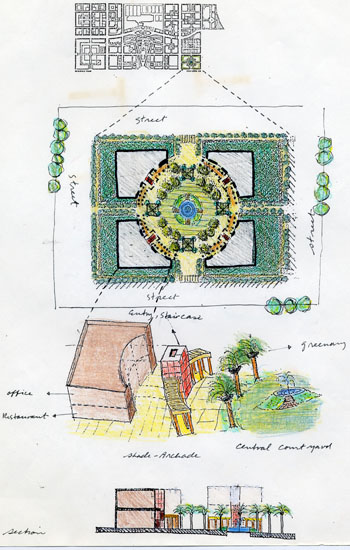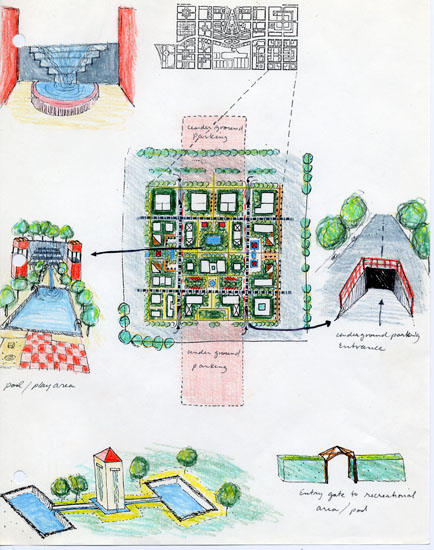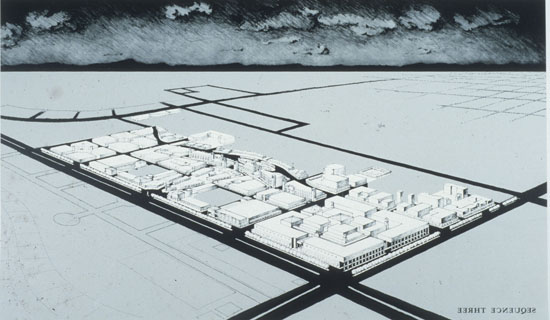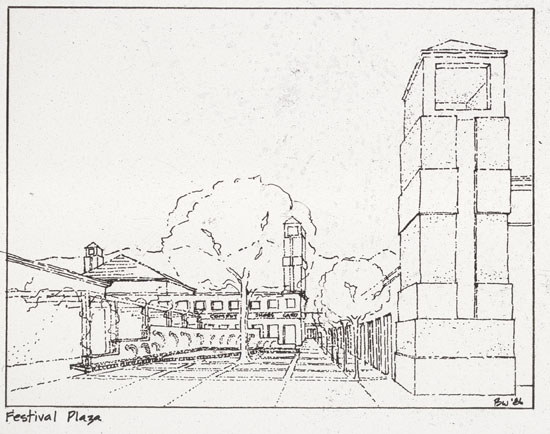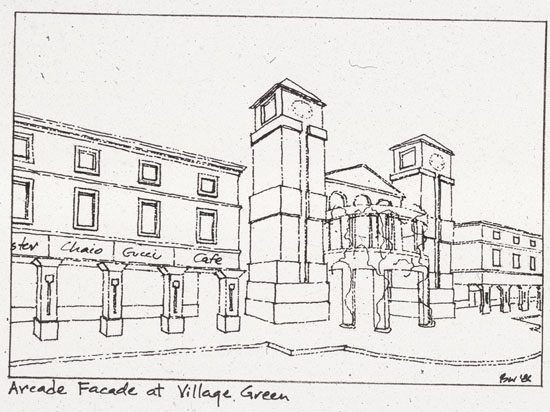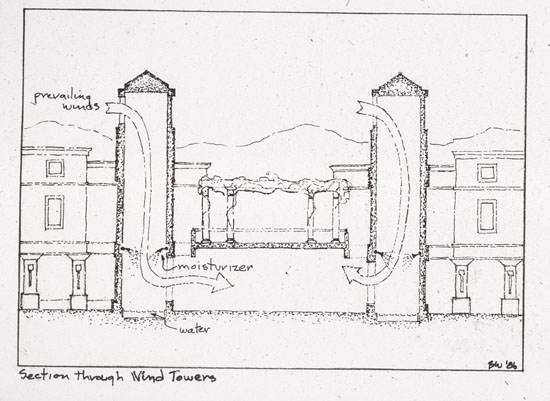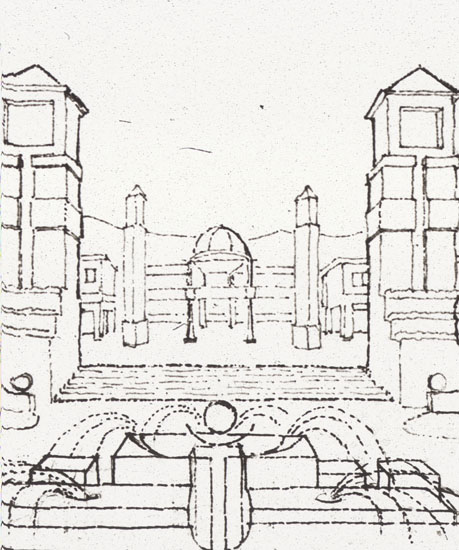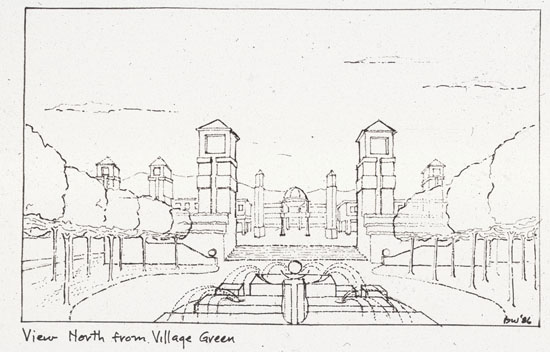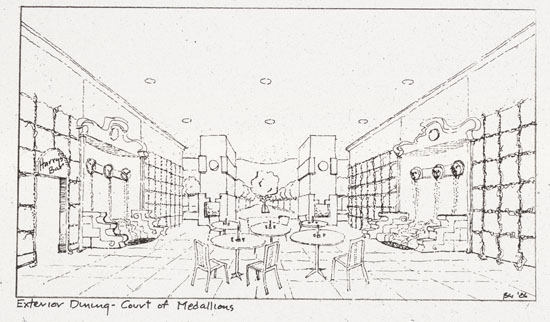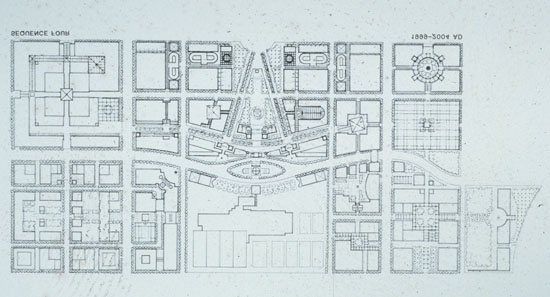Green Valley Town Center
- Subject:
- Town Center
- Project Number:
- 0745
- Date:
- April 8, 1980
- Client:
- American Nevada Corporation
- Location:
- Henderson, Nevada
- Project Name:
- Green Valley Town Center
A 10,000 population was sufficient to economically support a small town commercial center. Having watched Green Valley grow from sand dunes as far as the eye could see and sensing its future, Willis proposed a Town Center plan on the 75 acres along the northern edge of Green Valley community that would expand in stages, as Green Valley grew in population. The proposed Town Center was to be located at the corner of Green Valley Parkway where it crosses the four lanes of Sunset highway at the northern edge of the town and to be built in four stages.
Because the artifice of nearby Las Vegas overwhelms the region, we decided to address “the problem” hypothetically. Two questions were posed: can a stereotypically suburban armature produce a traditional urban center over time? Can myth-poetic environmentalism produce a meaningful architectonic vocabulary?
To address these questions the design team agreed on a 7-point design agenda: use traditional urbanism by emphasizing the street, the plaza, the village green and the atrium courtyard; utilize a traditionally sized grid of blocks and streets as a basis for commercial development, convenient parking and the establishment of neighborhood addresses; sequence a series of steps that anticipate the rate of residential growth in the community; embrace an urban landscape ideal that is utopian in a formal and visual sense, but use regional and native plant materials; recognize the pressures exerted by the natural environment upon pedestrians, buildings, public space and vehicles through a comprehensive and integrated design strategy for dealing with the seasonal extremes of the desert climate; attempt to establish an authentic, rather than artificial, regional architectural style, through a mytho-poetic process which links generic architectonic building expressions, regional decorative motifs and local materials; establish a neighborhood in the traditional sense by mixing housing, appropriate civic building types, like post offices, with commercial development to promote and prolong street activity before, during and after work hours.
We planned the east-to-west arcaded streets so that a flexible hierarchy of spaces and places like the shopping street and an orchard-like tree pattern in the parking lots. Vertical structures, like the tall, rectangular wind towers, were used as visual markers. The “cool-place” towers with internal misting water were designed to provide convective summer time cooling.
We laid out a 250 feet x 250 feet street grid that absorbed about 40% of the surface parking normally associated with retail development. This grid was scaled to accommodate and encourage pedestrian movement. The cornice heights of buildings were fixed in specific locations to allow adjacent special use buildings, such as a library and public spaces like the Village Green, to vary in size and shape.
The entry to the proposed enclosed shopping mall was on the corner of Green Valley Parkway and Sunset Highway. The entry to the mall in turn leads to a covered pedestrian shopping street, which circled a two-story department store located in the center. The department store would “anchor” this end of the main arcaded shopping street that traversed the length of the town center, ending at another department store. Offices were to be located in the two floors above the shops.
The proposed village green intersected at the center of the arcaded street. A children’s center, a four-plex movie house, and the ice skating rink edged the village green at the intersection with the curved arcaded street. Covered cafes, fast food, and leisurely dining facilities were designed to face onto the green, adjacent to the entertainment facilities, providing both day and nighttime activities. To the north of the Village Green we located a post office, sports, a two hundred rooms, five-story hotel, apartment and office buildings with retail, a park and playground.
The project was never built.
- “Project Reference File: Green Valley.” The Urban Land Institute July-September 1981.


